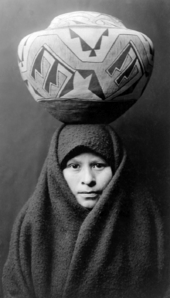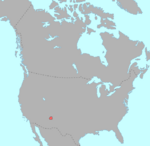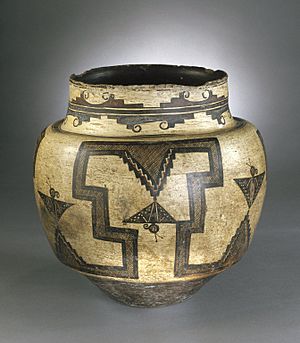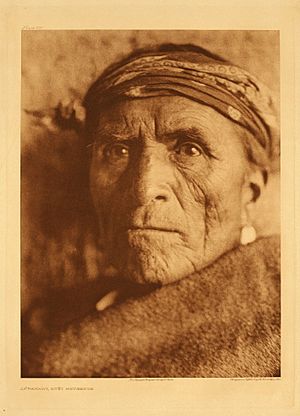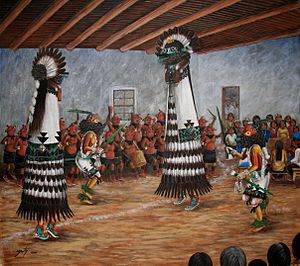Zuni facts for kids
|
Zuni girl with jar, 1903
|
|
| Total population | |
|---|---|
| (19,228 enrolled members (2015)) | |
| Regions with significant populations | |
| United States (New Mexico) | |
| Languages | |
| Zuni, English | |
| Related ethnic groups | |
| Hopi, Pueblo people |
The Zuni are a group of Native American people. They are known as Pueblo people because they live in villages called pueblos. The Zuni are officially recognized by the United States government.
Most Zuni people live in the Pueblo of Zuni. This village is located in western New Mexico, United States. It sits on the Zuni River, which flows into the Little Colorado River. The Zuni people call their homeland Shiwinnaqin.
Contents
How Many Zuni People Live Today?
In 2015, there were 19,228 people officially part of the Zuni tribe.
A Look at Zuni History

Scientists believe the Zuni people have been farmers in their current area for 3,000 to 4,000 years. They started using irrigation to grow maize (corn) a long time ago. Zuni culture is connected to the Mogollon and Ancestral Pueblo peoples. These groups lived in the deserts of New Mexico, Arizona, Utah, and Colorado.
A large Zuni village was built in the 11th century CE. By the 14th century, the Zuni lived in about a dozen pueblos. These villages had between 180 and 1,400 rooms. Most of these pueblos were left empty by 1400. Over the next 200 years, nine new large pueblos were built. These were the "seven cities of Cibola" that early Spanish explorers searched for. By 1650, only six Zuni villages remained.
First Contact with Europeans
In 1539, a man named Estevanico led a Spanish group to the Zuni lands. The Zuni people saw him as a spy and killed him. This was the first time the Spanish met any Pueblo people. Later, Francisco Vázquez de Coronado traveled through Zuni Pueblo.
The Spanish built a mission at Hawikuh in 1629. The Zunis tried to make the missionaries leave in 1632. But the Spanish built another mission in Halona in 1643.
The Pueblo Revolt and Return Home
Before the Pueblo Revolt of 1680, the Zuni lived in six different villages. After the revolt, they moved to a safe place on top of Dowa Yalanne. This is a very steep mesa (a flat-topped mountain) about 3.1 miles southeast of the current Zuni Pueblo. Dowa means "corn," and yalanne means "mountain."
After peace was made and the Spanish returned, the Zuni moved back to their current location. They only went back to the mesa top briefly in 1703.
In the mid-1800s, the Zunis were able to support themselves. However, they faced attacks from groups like the Apaches and Navajos. The United States government officially recognized their reservation in 1877. Over time, the Zuni farmed less. They started raising sheep and cattle to help their economy.
An Early Anthropologist Among the Zuni
Frank Hamilton Cushing, an anthropologist from the Smithsonian Institution, lived with the Zuni from 1879 to 1884. He was one of the first people to study a culture by living among them. However, he was criticized for sharing sacred photos and ceremonies that the Zuni believed should not be shown to outsiders.
Protecting Sacred Lands
In the early 2000s, there was a disagreement about a coal mine near the Zuni Salt Lake. This lake is very important and sacred to the Zuni people. The mine would have taken water from under the lake. It also would have built structures between the lake and the Zuni lands. The Zuni opposed this plan, and after several lawsuits, the mining project was stopped in 2003.
Zuni Culture and Traditions
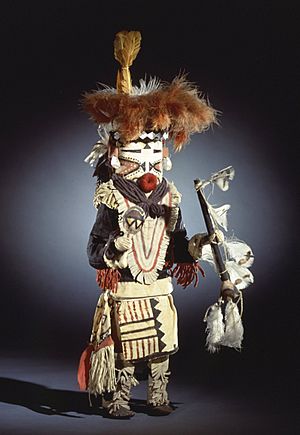
The Zuni people traditionally speak the Zuni language. This language is unique because it is a language isolate. This means it is not known to be related to any other Native American language. Experts believe the Zuni have kept their language pure for at least 7,000 years.
The Zuni still practice their traditional religion. They have regular ceremonies and dances. Their beliefs are independent and special to them.
The Zuni people have always been traditional. They live by irrigated agriculture (farming with water systems) and raising animals. They are good at farming in the desert because they carefully manage their resources. They also have a strong community that supports each other. Many Zuni today also earn money by selling traditional arts and crafts.
Some Zuni still live in the old-style pueblos. Others live in modern houses. Their home is a bit isolated, but they welcome visitors who are respectful.
The Zuni Tribal Fair and rodeo happens every year in August. The Zuni also take part in the Gallup Inter-Tribal Ceremonial. This event is usually held in early or mid-August. The A:shiwi A:wan Museum and Heritage Center is a museum that shows Zuni history, culture, and art.
Zuni Pottery Making
Traditionally, Zuni women made pottery to store food and water. They used symbols from their family groups (clans) for designs. The clay for pottery comes from local areas. Before taking the clay, the women give thanks to the Earth Mother (Awidelin Tsitda) in a special way.
The clay is ground up, then sifted and mixed with water. After the clay is rolled into a coil and shaped into a pot, it is smoothed with a tool. A thin layer of finer clay, called slip, is put on the surface to make it smoother and add color. The pot is polished with a stone after it dries. It is painted with natural dyes made at home, using a traditional yucca brush. The shape and pictures on the pottery depend on what it will be used for.
To bake the pottery, the Zuni used animal waste in traditional kilns (ovens). Today, Zuni potters might use electric kilns. When baking the pottery, people were often quiet or spoke softly. This was important to keep the "voice" of the clay and the purpose of the pot. Selling pottery and traditional arts is a main way many Zuni people earn money today. An artist might be the only financial support for her family. Many women make pottery, clothing, and baskets.
Zuni Carving and Silversmithing
The Zuni also make necklaces for rituals and trade. More recently, they make them to sell to collectors.
The Zuni are famous for their beautiful silversmithing. Zuni jewelers place turquoise stones in silver. Today, making jewelry is a very important art form among the Zuni. Many Zuni have become expert silversmiths. They have perfected the skill of stone inlay. This means they use small pieces of stone to create complex designs and unique patterns.
They often use small, oval-shaped stones with pointed ends. These are set close together in silver. This method is usually used with turquoise, sometimes with coral, and sometimes with onyx. They make necklaces, bracelets, earrings, and rings. This detailed setting method is called "needle point," and an even finer one is called "petit point."
Zuni Religious Beliefs
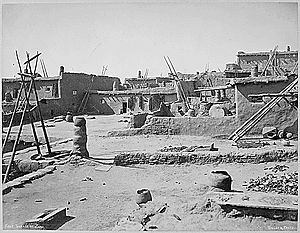
Religion is a very important part of Zuni life. Their religious beliefs focus on their most powerful deities (gods or spirits). These include Earth Mother, Sun Father, and Moonlight-Giving Mother. Other important figures are Old Lady Salt and White Shell Woman.
The Shalako Ceremony
Shalako is a series of special dances that happen all night long. They usually take place around the winter solstice (the shortest day of the year). This ceremony is private and not open to outsiders unless a Zuni tribal member invites them.
The ceremony also blesses new houses built during the year. The blessing involves singing that goes along with six dancers. These dancers wear very tall Shalako outfits, which can be up to eight feet high. The dancers represent "messengers of the rain spirits who come to bless new homes." The dancers move from house to house all night. At dawn, a person named Saiyatasha performs a final prayer, and the ceremony finishes.
Notable Zuni People
- Emily Pinto, a painter
- We'wha, a weaver
Images for kids
-
Zuni Girl, photographed by Edward S. Curtis
See also
 In Spanish: Zuni para niños
In Spanish: Zuni para niños


